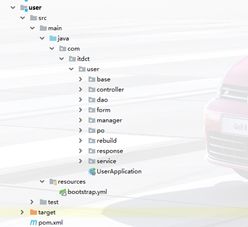【实战】SpringCloud搭建集群(非局域网)
作者:DCTANT
使用背景:将自己的微服务部署到各个地方,多个地方,通过虚拟机服务器和内网映射(穿透)的方法,通过云服务器的主服务访问这些微服务,以减轻云服务器(主服务)的负担,降低云服务器带来的高昂成本。且由于这些微服务部署到了各个地方,有好几套相同的,以至于挂了1~2个也不会导致整个系统崩溃。
创作背景:网上大部分教程都是基于同一个局域网中部署微服务集群,而没有牵涉到两个及以上处于完全不同地理位置的服务器,而为了搞定在不同网段内服务器之间的微服务通信,真的是踩了不少坑,才最终解决。
1. 准备两台及以上处于完全不同网段内的服务器
说么说是服务器,其实只需要找两台电脑即可,两台电脑必须都做到能够通过域名/公网IP访问,两台电脑之间能够互相ping通,不然一切都是白搭。
能做到这点的包括路由器虚拟机服务器和内网穿透。
2. 创建Eureka注册服务中心
IDEA建立一个Maven项目,我这里名叫testeureka,项目结构非常简单,关键在于配置文件application.yml怎么写

首先是EurekaServerApplication.java
@SpringBootApplication
@EnableEurekaServer
public class EurekaServerApplication {
public static void main(String[] args) {
SpringApplication.run(EurekaServerApplication.class, args);
}
@EnableWebSecurity
static class WebSecurityConfig extends WebSecurityConfigurerAdapter {
@Override
protected void configure(HttpSecurity http) throws Exception {
http.csrf().disable();
super.configure(http);
}
}
}
其中加入WebSecurityConfig是为了解决:Eureka加了连接密码认证后,出现的csrf拦截,导致服务无法注册。
这里参考了:https://www.jianshu.com/p/a40219751264
pom.xml
xsi:schemaLocation="http://maven.apache.org/POM/4.0.0 http://maven.apache.org/xsd/maven-4.0.0.xsd">
这里为了节省Maven下载时间,我使用的是Maven私服
最关键的是Eureka的application.yml文件
server:
port: 300
eureka:
instance:
hostname: ${spring.cloud.client.ip-address}
instance-id: ${spring.cloud.client.ip-address}:${server.port}
prefer-ip-address: true
ip-address: xyz.*****.com
non-secure-port: 4300
client:
# register-with-eureka: false
# fetch-registry: false
service-url:
defaultZone: http://test:TestPwd@xyz.*****.com:4300/eureka/, http:// test:TestPwd@abc.*****.com:1300/eureka/
spring:
security:
user:
name: test
password: TestPwd
application:
name: registy
server.port就是指定Eureka Server在内网中的端口(假定内网端口和映射到公网的端口不一样)
最主要的是Eureka.instance下的内容
2.1 hostname
用的是ip地址(其实没什么用),指定了prefer-ip-address后,hostname就形同虚设了,
2.2 instance-id
这里采用了ip+端口号的形式,其实可以随便填,怎么看的明白怎么写
2.3 prefer-ip-address
这个值为true的时候,注册到Eureka Server上的就使用ip地址,而不是主机名称(Windows系统下就是计算机名)
2.4 ip-address
ip地址,这里填写的是域名,即映射到公网的那个域名
2.5 non-secure-port
不安全情况下的端口,这里填写映射到公网的那个端口,我这边局域网中Eureka Sever的端口是300,但是映射到公网的是4300
2.6 register-with-eureka、fetch-registry
这两个参数在其他教程中一般要写成false,但是作为集群,那要互相注册,即Eureka Server A要注册到Eureka Server B,Eureka Server B也要注册到Eureka Server A,保证两边的注册服务信息是同步的,所以这里两个参数全部是true,而不像其他教程中置为false
2.7 service-url. defaultZone
连接到Eureka服务器的连接。由于我这里采用了密码验证的方式,防止陌生人将他自己的服务器注册到我的Eureka Server上,Eureka Server的多个地址采用“,”进行分割。单个Eureka Server的地址格式是:
http://${用户名}:${密码}@${Eureka服务的域名}:${Eureka服务的公网端口号}/eureka/
2.8 security
安全性,这里由name和password进行验证
2.9 application.name
应用的名称,这个名称会显示到Eureka服务列表里最左边一列Application中
3. 创建微服务客户端
这里采用用户微服务作演示
IDEA建立一个Maven项目,我这里取名叫user,首先是UserApplication.java
@SpringBootApplication
@EnableEurekaClient
public class UserApplication {
public static void main(String[] args) {
SpringApplication.run(UserApplication.class, args);
}
}
没什么多说的,结构非常简单
然后是pom.xml,由于所有这种业务结构的项目基础pom全部被我整合进serverbase这个jar包中了,以至于什么都看不到(来打我啊,哈哈!!)
xsi:schemaLocation="http://maven.apache.org/POM/4.0.0 http://maven.apache.org/xsd/maven-4.0.0.xsd">
由于我将这个项目的application.yml放到了ConfigServer中,文件都在码云上,因此我先放出bootstrap.yml中的内容
spring:
application:
name: user
cloud:
config:
enabled: true
username: ***
password: ***********
name: ${spring.application.name}
uri: http://www.*****.com:****
fail-fast: true
discovery:
service-id: config-server
很明显,我的ConfigServer也是有密码认证的,uri是ConfigServer在公网上的url
然后是在码云上的user.yml
eureka:
client:
service-url:
defaultZone: http://test:TestPwd@xyz.*****.com:4300/eureka/, http:// test:TestPwd@abc.*****.com:1300/eureka/
instance:
hostname: xyz.*****.com
instance-id: xyz.*****.com:4304
prefer-ip-address: true
ip-address: xyz.*****.com
non-secure-port: 4304
non-secure-port-enabled: true
server:
port: 304
spring:
application:
name: user
servlet:
multipart:
max-file-size: 256MB
datasource:
url: jdbc:mysql://www.*****.com:3306/user?useUnicode=true&useJDBCCompliantTimezoneShift=true&useLegacyDatetimeCode=false&serverTimezone=UTC&characterEncoding=utf8
username: *****
password: ************
driver-class-name: com.mysql.cj.jdbc.Driver
hikari:
auto-commit: true
idle-timeout: 30000
connection-timeout: 30000
minimum-idle: 5
type: com.zaxxer.hikari.HikariDataSource
jpa:
database: mysql
show-sql: false
hibernate:
ddl-auto: update
cloud:
config:
discovery:
service-id: user
enabled: true
其中大部分参数和之前Eureka中的配置是一模一样的,多出来的就是数据库方面的配置了。
最后是其他微服务使用RestTemplate去请求这个微服务了,这就不在多说了,网上有的是教程。
